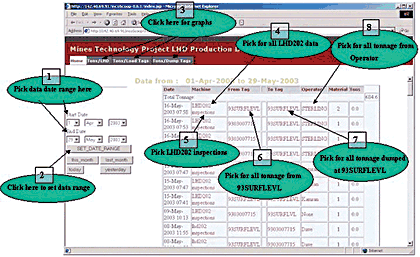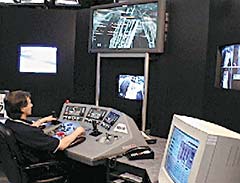"Typically, the communications services required by an underground mine are supplied by multiple communications structures," says Peter Cunningham, Senior Specialist in Inco's Technology Department. "But businesses outside the world of mining are benefiting from communications convergence, where voice, video, and data are supplied by one communications infrastructure. At the same time, there is
|
To this end, Inco is building and evaluating a wireless infrastructure consisting of a WiFi (802.11b) network and an active RFID tag-based visibility system at its McCreedy East mine in Levack, Ontario, Canada (see Figure 1).
Laying the Groundwork
In March 2004, Inco began installing a WiFi network, based on hardware from Cisco Systems Inc., at its McCreedy East facility, including the narrow-vein portion of the mine. Close to 80 access points were installed, and these were repackaged by Hardline Solutions to handle the harsh conditions in the mine. "A switch-access point combo is placed every 100 m to get around the 100 m limitation on Ethernet," says Cunningham.
The WiFi network serves as the backbone of the communications infrastructure. The new system was developed to provide the workforce with better voice communications than open-channel walkie-talkies could offer, and to replace end-of-life underground telephones. Because blasting operations during nearly every shift precluded running cables up to the workspace, wireless was a must. "There is a need to have a system to contact people working alone," says Cunningham. "Miners working alone need the ability to call for first aid or help. The miner has to be contacted every two hours by somebody or visited by a foreman to make sure he or she is OK."
Inco also wanted to track the output of front-end loaders, called scoop trams, which move broken ore, or muck, to dump points. "We wanted to be able to track that in near real time," says Cunningham. "Under the old system, the operators had to fill out a paper form indicating how much material they moved, where the material came from, and where it was deposited."
To improve monitoring and data collection from the trams, Inco installed a processor, bucket weighing system, and wireless modem on each piece of equipment. A touchscreen allows the operator to enter other information as well, such as whether the tram was moving rock or ore. Today, Inco's wireless network feeds these data to a Web-based application that shows in real time how many tons were picked up, how many were dumped, and by which machine (see Figure 2).
 Figure 2. To track the production of scoop trams that move broken ore to dump points, Inco?s wireless network feeds data from the trams to a Web-based application. The real-time information shows the number of tons picked up and dumped, and identifies the machine that did the work. |
"You want to look at your fleet to see if it is deployed properly," says Cunningham. "Maybe you need a truck or utility vehicle instead of a scoop tram. So you start looking at your whole fleet when you have all the machines outfitted with this system."
Enhanced Asset Tracking
Inco decided to take its network one step further so that it could monitor the location and movement of the more than 200 jeeps, electric trucks, and other nonproduction vehicles dispersed in the huge network of tunnels. "There are a lot of jeeps used to move personnel underground," says Cunningham. "And when the shift changes, the guys park the jeeps somewhere, and the next shift can spend a lot of time looking for one of these vehicles."
In 2005, Inco began testing and implementing AeroScout's active RFID tag-based Visibility System. Using the WiFi network's access points as readers, these tags, attached to the vehicles, send short 802.11b-formatted messages at predefined intervals, making it possible to accurately track the location of each asset. The tags feature long battery life (up to five years), a wireless programming interface, the ability to receive and store data messages, and a clear-channel assessment that avoids transmitting when WiFi data traffic is present.
The AeroScout engine is the core software component that manages the collection and processing of data from the WiFi access points. The server component of the engine processes received data to produce accurate, reliable location and presence information. "Under this system, you can find the vehicle just by looking at an electronic map that shows the locations of all of the tagged vehicles," says Cunningham.
Inco chose AeroScout's Visibility System for a number of reasons. "Proprietary readers are very expensive," says Gabi Daniely, vice president of marketing for AeroScout Inc., "and with the proprietary readers, Inco couldn't capitalize on the WiFi backend that they already had in place."
Inco is still evaluating the effectiveness of the overall system. "We are just at the beginning of this implementation," says Cunningham. "But we have six operating mines at this location. And I would imagine that if the active tag system proves itself at this mine, it will be implemented at the others. We know that we can do a lot better than we are doing now with the current systems. The question is, how much. It will help make the business case for implementing the active tag system throughout all of the mines."
Moving to the Surface
Inco is also beginning a project using the active RFID tags to optimize the operation of its surface truck fleet. In this application, roughly 27 contractors' trucks travel within a 50 km radius, which encompasses three mines. The trucks take ore from each mine and move it to a central dumping location. Tags are attached to each truck and exciters are positioned at choke points at each mine and the dumping site. As the trucks pass through the choke point (usually a gate), the exciter triggers the tags to transmit a message that is received by a location receiver. The system will provide Inco with information on travel times, routes, and dumping patterns. "They are going to use the visibility to achieve better usage of their truck fleet," says Daniely.
Future Plans
Inco will continue to reap benefits from its converged communications network and the active RFID tag visibility system. One particularly big-ticket item on the mining operation's balance sheet is the electricity required to operate the nearly 100 large underground fans that constitute part of the ventilation system. "Energy efficiency is low when the fans are running full tilt whether there are people in that part of the mine or not," says Cun-ningham. "You can save a lot on energy costs by knowing where equipment is and ramping the fans up or down depending on the location of people and equipment."
Next year, Inco hopes to initiate a project using its network and AeroScout's Visibility System to pinpoint areas of the mine in which there is activity. With this information, the company thinks it can achieve a significant savings.
